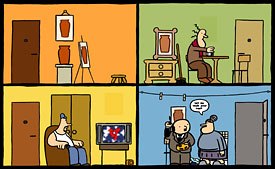Fred Galpern takes a look at the progress and advances in technology are shaping the future of the quality of gaming animation.

After taking last year off, Animated Encounters returned stronger than ever for a four-day run.
To answer the main question on the lips of animation fans regarding the Bristol International Animation Festival no, special guest Jeffery Katzenberg did not take the opportunity to do any juicy dissing of Michael Eisner, Disneys (ostensibly) outgoing ceo. The most the DreamWorks Animation honcho would offer in that direction was a light-hearted admission of why he helped establish a brand-new Hollywood studio. Namely, I got fired! he said.
The fifth Animated Encounters Bristol festival may not have had any great shocks or revelations, but it was a solidly mounted event, making a welcome return after a hiatus last year when the venue Bristols Watershed arts center underwent refurbishment. After a somewhat squeezed three-day event in 2003, it was back up to four days this year, a Thursday to a Sunday. Thursday and Friday were the Industry Days, with participants able to choose between two parallel strands of panels, talks and networking lunches, before the main festival and screenings kicked off on Friday evening.
The Katzenberg items effectively bridged the industry and populist sides, with Katzenberg in conversation with David Sproxton, co-founder of Aardman Animation, on Friday afternoon, then picking his favorite cartoon moments in the festivals traditional Desert Island Flicks that evening. He showed scant sign of his fearsome reputation as a hard-nosed Hollywood mover and shaker, being soft-spoken and courteous throughout the event, though not without an edge of polished sly humor.

During a daylong appearance, DreamWorks Jeffrey Katzenberg didnt diss Eisner, denied that 2D was dead and picked his Desert Island flicks.
Some of Katzenbergs material was familiar, but he took the opportunity to deny saying 2D was dead, claiming it simply needed to be reinvented and citing the I want song (with which Katzenberg was once associated) as an example of outmoded formula. He nominated Sylvain Chomets French The Triplets of Belleville as a fresh and original piece of 2D, and admitted he liked South Park. Asked by an audience member about Disneys offbeat Lilo & Stitch, Katzenberg said he enjoyed it, finding it very charming.
But theres no doubt where Katzenbergs own preferences lie. On DreamWorks next CGI projects, he noted the animal-oriented Madagascar would push deeper into territory unique to animation, as would upcoming DreamWorks films like next years Over the Hedge. However, he said DreamWorks was already committing to movies (due round 2009) that would head into other territory. Like Pixars The Incredibles, they would tell stories that one could imagine working in live-action, but not as weve done them.
This writer took the opportunity to ask Katzenberg if he still tensed at the word cartoon being used to describe a film like Shrek. (Interviewed promoting Shrek at Cannes, Katzenberg was quoted as saying the word placed cartoons into a little ghetto called childrens stories.) Katzenberg said no: he had once felt the word was pejorative, with connotations of Saturday mornings, but he was now proud to call Madagascar the cartooniest CGI film to date, with character rigs allowing for more squash-and-stretch.
On the future of CGI, Katzenberg predicted a migration into 3D without glasses. (A scene from DreamWorks 3D Shrek was shown at Animated Encounters three years ago, though the film was never finished.) The new Popes election prompted Katzenberg to recall how he showed Prince of Egypt at the Vatican to an assembly of cardinals. Afterwards, he debated the films Old Testament theology with them. It was as nutty as anything in my lifetime, he said, stressing he was still proud of Prince.
A few hours after the IMAX talk, Katzenberg moved into the Watershed Centre for Desert Island Flicks. The interviewer was Mark Kermode, a British film critic well known for insisting that The Exorcist is the greatest film ever. Katzenberg presumably had no idea of this, but when Kermode got misty-eyed and metaphysical about Mary Poppins, the guest took the cue to rib Kermode to the audiences great enjoyment.
Seven of Katzenbergs picks were features; he excluded DreamWorks, but chose two films he oversaw at Disney. One was Little Mermaid, from which Katzenberg chose the Part of Your World song. He recalled the film went badly over budget, so savings had to be made; Ariel was planned to have 11 colors, reduced to seven at a saving of $750,000 in 1980s money. Intriguingly, Katzenberg mused if Mermaid might have made more money had it come out after the high of Lion King, not a film on Katzenbergs list.
Katzenberg also picked the ballroom dance scene from Beauty and the Beast, describing it as the moment where the camera gained wings. Beyond the 3D, he cited a piece of animation in the scene that had to be reworked three times. Its when Belle takes the Beasts hand and puts it on her hip. You see the generosity on her face, the genuine revelation on his its the key moment, the understanding, I love you. Its the perfect moment. Katzenberg cited Beauty and the Beast as his favorite animation overall.
From Disneys Golden Age, Katzenberg picked the climax to Pinocchio, where Monstro chases the puppet and Geppetto on their raft. His other picks included Fantasia, Mary Poppins (the dance with the penguins), the first Toy Story, Hayao Miyazakis Spirited Away and Nick Parks The Wrong Trousers. Ninth was Chuck Jones short One Froggy Evening, while the last pick, undoubtedly personal, was the Coca-Cola advert with the CG polar bears, perhaps reflecting Katzenbergs love for Diet Coke at brainstorming sessions.

Oscar-winner Chris Landreth talked about the making of his landmark film, Ryan, and reminded attendees that extraordinary CGI effects could be part of a firmly auteur-driven animation. Photo credit: Shira Avni.
Aside from Katzenberg, the other big name at the festival was Chris Landreth, the director of the extraordinary Oscar-winning Ryan, as if to remind us that dazzling CGI effects could be part of a firmly auteur-driven animation. Landreth did a talk on the creation of the landmark film on Thursday afternoon, which, unfortunately, I wasnt able to see. Needless to say, though, Ryan went down a storm when it was shown as part of the Inspirational International strand.
Clare Kitson did an excellent presentation (based on her new book) about an earlier seminal short film, Yuri Norsteins Tale of Tales. She spoke lucidly of the films deeply autobiographical nature, as well as the oppressive circumstances of its production. Its no small achievement that one came out of Kitsons presentation feeling this strange Russian film was finally understandable.
Another old film represented, though it would be contentious to call it a classic like Ryan or Tale of Tales, was Ralph Bakshis notorious 1974 feature, Coonskin, also known as Streetfight. The film was shown on Friday night in a rare surviving film print (allegedly one of only four remaining). It was certainly fascinating as an experience, though nothing in the sometimes brutishly limited animation matched the biting opening song, Ahm a Nigger-Man, written by Bakshi himself and sung by Scatman Crothers. For Bakshi novices, it was overwhelming what we really needed was a talk and discussion supplementing the screening, à la Kitsons exegesis on Tale of Tales.
The weekend saw a total of eight animated short strands (rounded off by a Best of compilation on Sunday evening). There were international and childrens programs, plus two strands representing the U.K., Europe and Emerging Talent. It must be said that the Inspirational International program rather overshadowed the others, given its classy roster. The CGI titles included Sejong Parks Birthday Boy, made in Australia, but offering an affectingly vivid childs-eye portrait of the Korean war; Konstantin Bronzits cheeky Russian The God, an excellent exploration of a simple gag; Cherry Clouds, a slight but sweet tale of first love from Japans Akane-Maru; and the hilarious Oscar nominee Gopher Broke, which could easily accompany any Pixar feature.
I couldnt connect to Mike Gabriels Disney short Lorenzo, good-looking though it was, but Saddam and Osama, directed by David Wachtenheim and Robert Marianetti, was a bad-taste hoot that successfully poked fun at classic Saturday-morning TV.
On the U.K. side, I wasnt too involved in Fernando Carmos 10-minute CGI Hope, premiering here, which seemed a lot of heavy weather over whimsy, but The Unswept Floor by Jane Hubbard was an intelligent idea well-handled, probing backward through a non-descript floor through the ages. Matthew Gravelles 2D Taps was a likable sketch summed up by its title, as was Owen Simons CGI Mischievous Mirrors. Stalk, by Leigh Hodgkinson, only managed to help fill the festivals quota for the alienatingly bizarre, but Daniel Greaves Little Things was a wonderfully sustained exercise in farcical escalation.

Jonas Geirnaert's Flatlife found crazy links in a four-room-on-screen set-up. © Jonas Geirnaert.
Greaves film found counterparts of sorts in a couple of the European films, Francois Rouxs delightfully silly Blues Stories (which used vocal sound effects that should translate to most cultures on the planet) and Jonas Geirnaerts Belgian Flatlife, which found fantastical potentials and crazy links in a four-room-on-screen set-up. I wasnt so taken with the other programs I saw, though Dying of Love (by the Spanish Gil Alkabetz) was a nicely bittersweet 2D love story told through the eyes of two caged parrots who inadvertently reveal a dreadful secret, while Arthur de Pins served up the charmingly po-faced French Revolution of the Crabs.
Meanwhile, Francis Nielsen was on hand to introduce his feature film, The Dog, the General and the Birds, a tale of 19th-century St Petersburg with designs inspired by Chagall. I was only able to see the first 40 minutes, but frankly, it seemed mediocre at best, and far from Triplettes of Belleville.

The awards audience was treated to a tantalizing few minutes of Nick Parks latest effort, the long-awaited Wallace and Gromit feature, subtitled, Curse of the Were-Rabbit. © Aardman Animation. Courtesy of DreamWorks.
Saturday evening saw a lively awards ceremony with three separate prizes given out. The heftily-named OLC/Rights Entertainment International Newcomer Award is a Japanese prize, presented by the companys president Tadaki Okada. The winner, chosen by the festival jury, was Oury Atlans Overtime, a CGI film that left me gaping at the sheer effrontery of what some viewers (and Jim Henson fans in particular) might easily take as monumental bad taste, or as it was no doubt intended as a fantastical elegy to the puppet genius. (Overtime was one of two ostentatiously monochrome CGI fantasies at the festival, the other being Marc Crastes award-winning U.K. JoJo in the Stars, which I found superficially impressive but unmemorable). Meanwhile, the Childrens Award, chosen by 11- to 18-year-olds, went to Paul Taylors shamelessly enjoyable prehistoric crowd-pleaser, In the Rough.
Finally, the overall audience award and this years British nomination for the Cartoon Dor went to Through My Thick Glasses, a Canadian-Norwegian wartime memoir directed by Pjotr Sapegin. A 3D model film, it successfully balanced Aardman-style whimsy with heartfelt eulogy. It was nice to see a stop-frame film triumph in Aardmans hometown, before the awards audience was treated to a tantalizing few minutes of Nick Parks latest effort, the long-awaited Wallace and Gromit feature, subtitled Curse of the Were-Rabbit. And how do the prospects look? Well, enough to say that everything the Oscar-winning Close Shave did for sheep, Were-Rabbit promises to do for bunnies
Andrew Osmond is a freelance writer specializing in fantasy media and animation.







